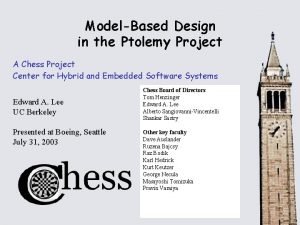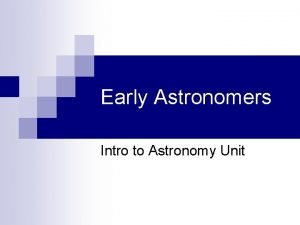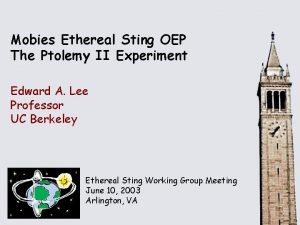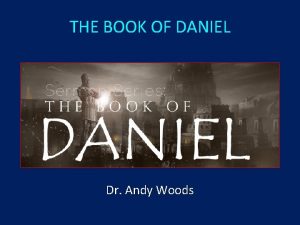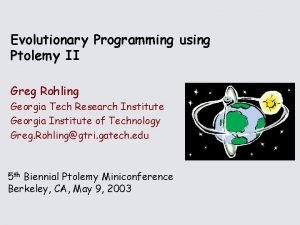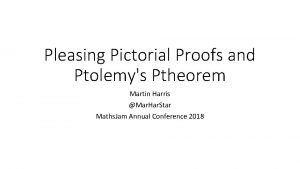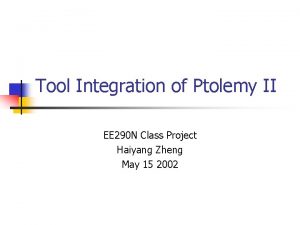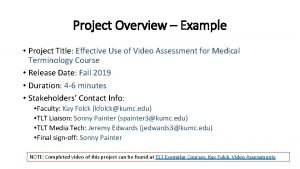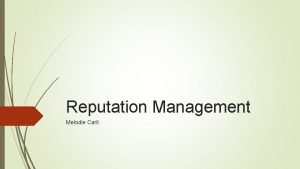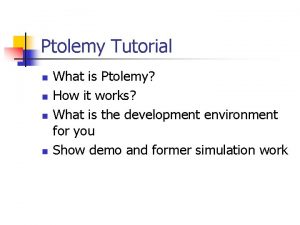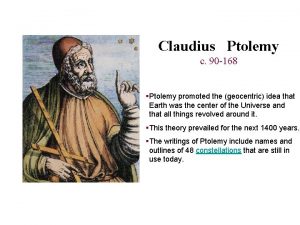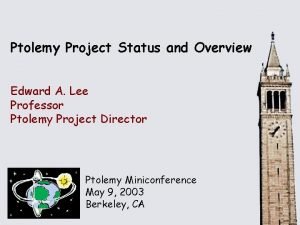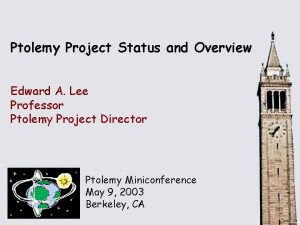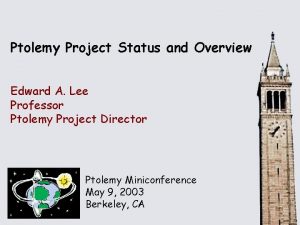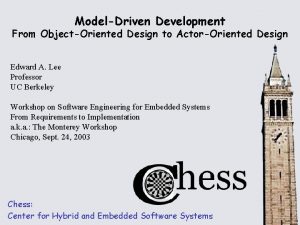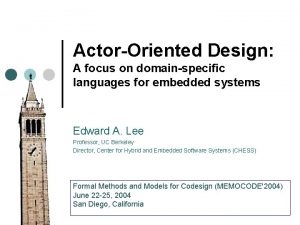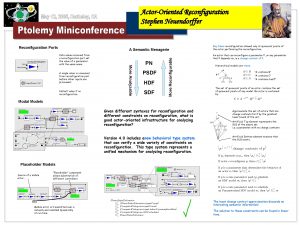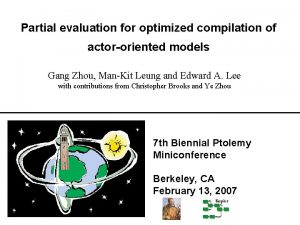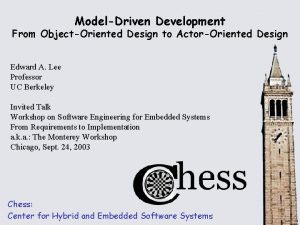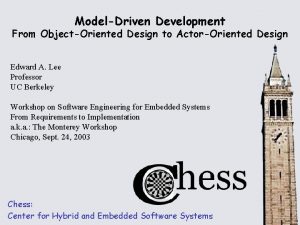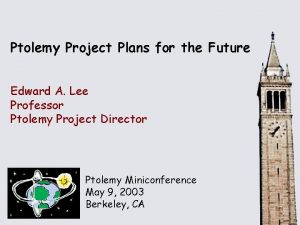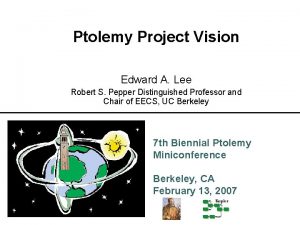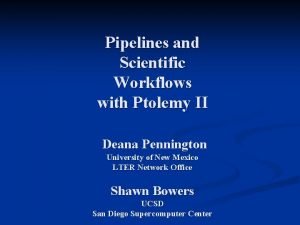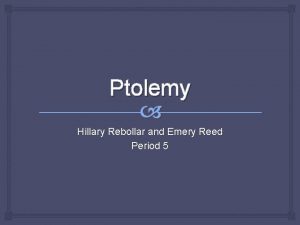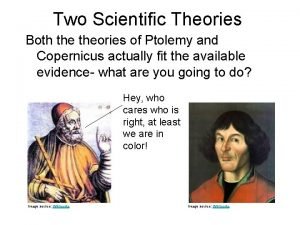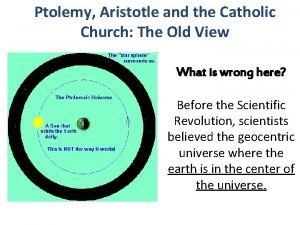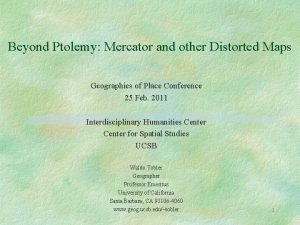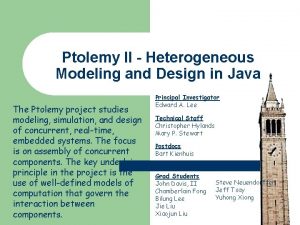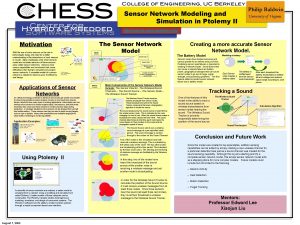An Overview of the Ptolemy Project and ActorOriented

























































- Slides: 57

An Overview of the Ptolemy Project and Actor-Oriented Design Edward A. Lee Professor UC Berkeley OMG Technical Meeting Feb. 4, 2004 Anaheim, CA, USA Special thanks to the entire Ptolemy Team. Center for Hybrid and embedded software systems

Abstract The Ptolemy Project at UC Berkeley studies modeling, simulation, and design of concurrent, real-time, and embedded systems. The focus is on assembly of concurrent components under "actor-oriented" models of computation, where components are conceptually concurrent and communicate through one of several messaging schemas. This talk describes the principles of actor-oriented design, including common features across models of computation, such as abstract syntax and type systems, and features that differ across models of computation, such concurrent threads of control and messaging schemas. Mechanisms that support the use of heterogeneous mixtures of models of computation are also described. The Ptolemy II system, which is the experimental framework used by the project in its investigations, will be described and used to illustrate key points. The Ptolemy Project at UC Berkeley is part of Chess, the Berkeley Center for Hybrid and Embedded Software Systems. Lee, UC Berkeley 2

Ptolemy Project Participants Director: ¢ Edward A. Lee Staff: ¢ Christopher Hylands ¢ Susan Gardner (Chess) ¢ Nuala Mansard ¢ Mary P. Stewart ¢ Neil E. Turner (Chess) ¢ Lea Turpin (Chess) Graduate Students: ¢ ¢ ¢ J. Adam Cataldo Chris Chang Elaine Cheong Sanjeev Kohli Xiaojun Liu Eleftherios D. Matsikoudis Stephen Neuendorffer James Yeh Yang Zhao Haiyang Zheng Rachel Zhou Postdocs, Etc. : ¢ Joern Janneck, Postdoc ¢ Rowland R. Johnson, Visiting Scholar ¢ Kees Vissers, Visiting Industrial Fellow ¢ Daniel Lázaro Cuadrado, Visiting Scholar Lee, UC Berkeley 3

Software Legacy of the Project ¢ Gabriel (1986 -1991) l l l ¢ Ptolemy Classic (1990 -1997) l l l l ¢ Each of these served us, first-and-foremost, as a laboratory for investigating design. Written in Lisp Aimed at signal processing Synchronous dataflow (SDF) block diagrams Parallel schedulers Code generators for DSPs Hardware/software co-simulators Written in C++ Multiple models of computation Hierarchical heterogeneity Dataflow variants: BDF, DDF, PN C/VHDL/DSP code generators Optimizing SDF schedulers Higher-order components Ptolemy II (1996 -2022) l l l l Written in Java Domain polymorphism Multithreaded Network integrated and distributed Modal models Sophisticated type system CT, HDF, CI, GR, etc. ¢ Pt. Plot (1997 -? ? ) l ¢ Tycho (1996 -1998) l ¢ Java plotting package Itcl/Tk GUI framework Diva (1998 -2000) l Java GUI framework Focus has always been on embedded software. Lee, UC Berkeley 4

Ptolemy Classic Example From 1995 (adaptive nulling in an antenna array) streams hierarchical components higher-order components Ptolemy application developed by Uwe Trautwein, Technical University of Ilmenau, Germany Lee, UC Berkeley 5

Ptolemy II Hierarchical component modal model Ptolemy II: Our current framework for experimentation with actor-oriented design, concurrent semantics, visual syntaxes, and hierarchical, heterogeneous design. Ptolemy II is truly free software (cf. GPL) dataflow controller http: //ptolemy. eecs. berkeley. edu example Ptolemy II model: hybrid control system Lee, UC Berkeley 6

At Work in the Chess Software Lab Chess = Center for Hybrid and Embedded Software Systems Lee, UC Berkeley 7

big gap Platforms A platform is a set of designs. Relations between platforms represent design processes. Lee, UC Berkeley 8

Progress Many useful technical developments amounted to creation of new platforms. microarchitectures ¢ operating systems ¢ virtual machines ¢ processor cores ¢ configurable ISAs ¢ Lee, UC Berkeley 9

Desirable Properties From above: ¢ modeling ¢ expressiveness From below: ¢ correctness ¢ efficiency Lee, UC Berkeley 10

Model-Based Design Model-based design is specification of designs in platforms with “useful modeling properties. ” Lee, UC Berkeley 11

Recent Action Giving the red platforms useful modeling properties (e. g. verification, System. C, UML, MDA) Getting from red platforms to blue platforms (e. g. correctness, efficiency, synthesis of tools) Lee, UC Berkeley 12

Better Platforms with modeling properties that reflect requirements of the application, not accidental properties of the implementation. Lee, UC Berkeley 13

How to View This Design From above: Signal flow graph with linear, timeinvariant components. From below: Synchronous concurrent composition of components Lee, UC Berkeley 14

Actor-Oriented Design Object orientation: class name What flows through an object is sequential control data methods call return Actor orientation: actor name data (state) parameters ports Input data Output data What flows through an object is streams of data Lee, UC Berkeley 15

Actor Orientation vs. Object Orientation Object oriented Actor oriented Text. To. Speech initialize(): void notify(): void is. Ready(): boolean get. Speech(): double[] OO interface definition gives procedures that have to be invoked in an order not specified as part of the interface definition. ¢ Identified problems with object orientation: l l ¢ actor-oriented interface definition says “Give me text and I’ll give you speech” Says little or nothing about concurrency and time Concurrency typically expressed with threads, monitors, semaphores Components tend to implement low-level communication protocols Re-use potential is disappointing Actor orientation offers more potential for useful modeling properties, and hence for model-based design. Lee, UC Berkeley 16

“Actors” vs. “Capsules” ¢ Actors are more like UML capsules than like UML actors ¢ The term “actors” was introduced in the 1970’s by Carl Hewitt of MIT to describe autonomous reasoning agents. ¢ The term evolved through the work of Gul Agha and others to refer to a family of concurrent models of computation, irrespective of whether they were being used to realize autonomous reasoning agents. ¢ The term “actor” has also been used since 1974 in the dataflow community in the same way, to represent a concurrent model of computation. Lee, UC Berkeley 17

Abstract Syntax: Hierarchical Entities, Ports, Connections and Attributes Our abstract syntax choices: • • Abstract syntax defines the structure of a model, but says little about what it means. • Hierarchy is tree structured (like XML). A relation mediates connections. Ports can link multiple relations and relations can link multiple ports. Ports mediate connections across levels of the hierarchy (no statecharts-style levelcrossing links) … Lee, UC Berkeley 18

Mo. ML – An XML Concrete Syntax (Modeling Markup Language) <? xml version="1. 0" standalone="no"? > <!DOCTYPE model PUBLIC "…" "http: //…"> <model name="top" class="path name"> <entity name="source" class="path name"> <port name="output"/> </entity> <entity name="sink" class="path name"> <port name="input"/> </entity> <relation name="r 1" class="path name"/> <link port="source. output" relation="r 1"/> <link port="sink. input" relation="r 1"/> </model> Mo. ML is the persistent file format of Ptolemy II. Lee, UC Berkeley 19

Visual Renditions of Models Ptolemy II model rendered in Vergil, a visual editor: Lee, UC Berkeley 20

Semantics of Producer/Consumer Components Models of Computation: • continuous-time • dataflow • rendezvous • discrete events • synchronous • time-driven • publish/subscribe • … This abstract syntax is compatible with many semantic interpretations. The concurrency and communication model together is what we call the model of computation (Mo. C). Lee, UC Berkeley 21

Examples of Actor-Oriented Component Frameworks ¢ ¢ ¢ ¢ Simulink (The Math. Works) Labview (National Instruments) Modelica (Linkoping) Polis & Metropolis (UC Berkeley) OCP, open control platform (Boeing) GME, actor-oriented meta-modeling (Vanderbilt) SPW, signal processing worksystem (Cadence) System studio (Synopsys) ROOM, real-time object-oriented modeling (Rational) Easy 5 (Boeing) Unlike Ptolemy II, Port-based objects (U of Maryland) most of these define a I/O automata (MIT) fixed model of VHDL, Verilog, System. C (Various) computation. … Lee, UC Berkeley 22

Ptolemy Project Principle The model of computation is not built in to the software framework. Director from a library defines the model of computation Mo. C-polymorphic component library. Lee, UC Berkeley 23

Actor-Oriented Design is not One But Many Techniques A rich set of possible semantic and syntactic approaches, each with useful modeling and implementation properties. Lee, UC Berkeley 24

Actor-Oriented Platforms Actor oriented models compose concurrent components according to a model of computation. Lee, UC Berkeley 25

Examples of Models of Computation ¢ ¢ ¢ ¢ ¢ Dataflow Discrete events Each of these has several Continuous time competing Finite state machines variants Synchronous reactive Time driven Publish and subscribe Communicating sequential processes Process networks … Lee, UC Berkeley 26

Start With Dataflow ¢ ¢ ¢ ¢ ¢ Computation graphs [Karp & Miller - 1966] Visual programs [Sutherland – 1966] Process networks [Kahn - 1974] Static dataflow [Dennis - 1974] Dynamic dataflow [Arvind, 1981] Structured dataflow [Matwin & Pietrzykowski 1985] K-bounded loops [Culler, 1986] Synchronous dataflow [Lee & Messerschmitt, 1986] Structured dataflow [Kodosky, 1986] PGM: Processing Graph Method [Kaplan, 1987] Synchronous languages [Lustre, Signal, 1980’s] Well-behaved dataflow [Gao, 1992] Boolean dataflow [Buck and Lee, 1993] Multidimensional SDF [Lee, 1993] Cyclo-static dataflow [Lauwereins, 1994] Integer dataflow [Buck, 1994] Bounded dynamic dataflow [Lee and Parks, 1995] Heterochronous dataflow [Girault, Lee, & Lee, 1997] … Many tools, software frameworks, and hardware architectures have been built to support one or more of these. Lee, UC Berkeley 27

Synchronous Dataflow (SDF) (Lee and Messerschmitt, 1986) SDF director SDF offers feedback, multirate, static scheduling, deadlock analysis, parallel scheduling, static memory allocation. Lee, UC Berkeley 28

Synchronous Dataflow (SDF) Fixed Production/Consumption Rates l Balance equations (one for each channel): l Schedulable statically Get a well-defined “iteration” Decidable: l l number of tokens consumed number of firings per “iteration” number of tokens produced buffer memory requirements deadlock fire A { … produce N … } channel N M fire B { … consume M … } Lee, UC Berkeley 29

Dynamic Dataflow (DDF) ¢ Actors have firing rules l l l ¢ Scheduling objectives: l l l ¢ Do not stop if there are executable actors Execute in bounded memory if this is possible Maintain determinacy if possible Policies that fail: l l ¢ Set of finite prefixes on input sequences For determinism: No two such prefixes are joinable under a prefix order Firing function applied to finite prefixes yield finite outputs key properties of DDF models are undecidable Data-driven execution (deadlock, bounded memory, schedule) Demand-driven execution Fair execution Many balanced data/demand-driven strategies Policy that succeeds (Parks 1995): l l Execute with bounded buffers Increase bounds only when deadlock occurs Lee, UC Berkeley 30

Application of Dynamic Dataflow: Resampling of Streaming Media ¢ ¢ This pattern requires the use of a semantically richer dataflow model than SDF because the Boolean. Switch is not an SDF actor. This has a performance cost and reduces the static analyzability of the model. Lee, UC Berkeley 31

Undecidability: What SDF Avoids (Buck ’ 93) Sufficient set of actors for undecidability: l l l boolean functions on boolean tokens switch and select initial tokens on arcs b boolean function 1 1 ¢ b T F 1 - b 1 1 1 switch 1 select ¢ 1 T F 1 - b initial token Undecidable: l l l deadlock bounded buffer memory existence of an annotated schedule Lee, UC Berkeley 32

Resampling Design Pattern using Hierarchical Heterogeneity Hierarchically mixing synchronous dataflow with finite state machines offers a much more powerful model of computation than either alone. And everything remains decidable! Lee, UC Berkeley 33

State Machines & Block Diagrams guard/action invariant/activity A signal Sequential C B D Concurrent actor Lee, UC Berkeley 34

Useful State Machine Models ¢ ¢ ¢ Von-Neumann computers Imperative programming languages Finite state machines (FSMs) Lee, UC Berkeley 35

Concurrency + Control Logic Discrete-event model (e. g. environment model) DE A Compositional construction C B D x x y z y z z Control logic CT E F G Continuous-time modeling of physical subsystems Concurrent FSMs CT E F G Modal model Lee, UC Berkeley 36

Contrast With Statecharts ¢ Statecharts bundle orthogonal semantic issues l l ¢ state machines concurrency Statecharts chooses synchronous semantics for the concurrency model l what if I want an asynchronous model? what if I want continuous time (to get hybrid systems)? what if I want time-stamped discrete events? Lee, UC Berkeley 37

The Principle of Hierarchical Heterogeneity A E C G B F D H E G “Use the best tool for the job. ” F H With some discipline, you can use distinct semantics at different levels of the hierarchy. Lee, UC Berkeley 38

Example: Heterochronous Dataflow (HDF) Combines Dataflow with FSMs We can keep everything decidable, but greatly improve expressiveness. Lee, UC Berkeley 39

Another Example: Hybrid Systems Combines Continuous Time with FSMs Hybrid systems are hierarchical combinations of continuous-time models and state machines. Lee, UC Berkeley 40

Heterogeneous Models We refer to models that combine FSMs hierarchically with concurrent models of computation as modal models. Modal models are one example of a family of hierarchically heterogeneous models, where diverse models of computation are combined in a hierarchy. Lee, UC Berkeley 41

How Does This Work? Abstract Semantics is the Key flow of control ¢ Initialization ¢ Execution ¢ Finalization n preinitialize() n declare static information, like type constraints, scheduling properties, temporal properties, structural elaboration n initialize() communication n initialize variables ¢ Structure of signals ¢ Send/receive protocols Lee, UC Berkeley 42

Abstract Semantics – The Key To Hierarchical Heterogeneity flow of control ¢ Initialization ¢ Execution ¢ Finalization n iterate() communication ¢ Structure of signals ¢ Send/receive protocols Lee, UC Berkeley 43

Abstract Semantics – The Key To Hierarchical Heterogeneity flow of control ¢ Initialization ¢ Execution ¢ Finalization The order in which component methods prefire(), postfire(), depends on the model of computation. n prefire() n iterate() communication ¢ Structure of signals ¢ Send/receive protocols n fire() n postfire() n stop. Fire() In hierarchical heterogeneity, the fire() method iterates a submodel, but according to its model of computation. Lee, UC Berkeley 44

Lifecycle Management ¢ It is possible to hierarchically compose the Ptolemy II abstract semantics. ¢ Actors providing common patterns: l l ¢ Run. Composite. Actor is a composite actor that, instead of firing the contained model, executes a complete lifecycle of the contained model. Model. Reference is an atomic actor whose function is provided by a complete execution of a referenced model in another file or URL. Provides systematic approach to building systems of systems. Lee, UC Berkeley 45

Hierarchical Composition of the Ptolemy II Abstract Semantics flow of control ¢ Initialization ¢ Execution ¢ Finalization n prefire() n iterate() communication ¢ Structure of signals ¢ Send/receive protocols n fire() n postfire() n initialization n Execution n Finalization n stop. Fire() Lee, UC Berkeley 46

Other Stream-Like Models of Computation Compatible with this Abstract Semantics ¢ Discrete events (e. g. NS) l ¢ Synchronous languages (e. g. Esterel) l l ¢ l separate thread per actor asynchronous communication Communicating sequential processes l l ¢ similar, but no fixed-point semantics Process networks l ¢ sequence of values, one per clock tick fixed-point semantics Time triggered (e. g. Giotto) l ¢ data tokens have time stamps separate thread per actor synchronous communication Push/Pull (e. g. Click) l dataflow with disciplined nondeterminism Lee, UC Berkeley 47

Is Using Visual Syntaxes a Good Idea? Example: Need to separately process elements of an array ¢ naïve approach: l l array in elements out ¢ ¢ ¢ 8 elements 8 signal paths hard to build hardwired scale distributor: l converts an array of dimension 8 to a sequence of 8 tokens. Lee, UC Berkeley 48

Scalability of Visual Syntaxes Iteration by Dataflow ¢ Although sometimes useful, this design pattern has limitations: l l l array size must be statically fixed actor to iterate must be stateless, or desired semantics must be to carry state across array elements Lee, UC Berkeley 49

Analogy to Structured Programming in Actor-Oriented Models ¢ A library of actors that encapsulate common design patterns: l l l ¢ ¢ Iterate. Over. Array: Serialize an array input and provide it sequentially to the contained actor. Map. Over. Array: Provide elements of an array input to distinct instances of the contained actor. Zip, Scan, Case, … Like the higher-order functions of functional languages, but unlike functions, actors can have state. The implementation leverages the abstract semantics of Ptolemy II. Lee, UC Berkeley 50

What About All Those Wires? If You Don’t Want Them, Don’t Use Them model of a sensor node ¢ ¢ ¢ Ptolemy II framework for modeling wireless sensor networks Connectivity is wireless Customized visualization Location-aware models Channel models include: l l ¢ Component models include: l l l model of a channel packets losses power attenuation distance limitations collisions Antenna gains Terrain models Jamming Lee, UC Berkeley 51

What About Abstraction? These 49 sensor nodes are actors that are instances of the same class, defined as: Lee, UC Berkeley 52

What About Modularity? Making these objects instances of a class rather than copies reduced the XML representation of the model from 1. 1 Mbytes to 87 k. Bytes, and offered a number of other advantages. The definition below is a class and objects at the left are instances, not copies. Lee, UC Berkeley 53

Now that we have classes, can we bring in more of the modern programming world? ¢ ¢ ¢ subclasses? inheritance? interfaces? subtypes? aspects? Lee, UC Berkeley 54

Actor Interfaces: Ports and Parameters input ports parameters: a 1 = value a 2 = value Example: output port p 1 p 3 p 2 input/output port Lee, UC Berkeley 55

Subclasses? Inheritance? Interfaces? Subtypes? Aspects? Yes We Can! ¢ subclasses and inheritance l ¢ hierarchical models that inherit structure from a base class interfaces and subtypes l ¢ These are a part of what the Berkeley Center for Hybrid and Embedded Software Systems (Chess) is doing. ports and parameters of actors form their interface aspects l heterarchical models interweave multiple hierarchies, providing true multi-view modeling. All of these operate at the abstract syntax level, and are independent of the model of computation, and therefore can be used with any model of computation! Thus, they become available in domain-specific actor-oriented languages. Lee, UC Berkeley 56

Conclusion ¢ Actor-oriented design remains a relatively immature area, but one that is progressing rapidly. ¢ Ptolemy II is free and open software for experimenting with actor-oriented design techniques. ¢ see http: //ptolemy. eecs. berkeley. edu Lee, UC Berkeley 57
 Drect
Drect Claudius ptolemy astronomy contributions
Claudius ptolemy astronomy contributions Claudius ptolemy astronomy contributions
Claudius ptolemy astronomy contributions Ptolemy experiment
Ptolemy experiment Ptolemy
Ptolemy Greg ptolemy
Greg ptolemy Ptolemy theorem
Ptolemy theorem Ptolemy tool
Ptolemy tool Title of the project example
Title of the project example Sap ps
Sap ps Project management topics
Project management topics Hát kết hợp bộ gõ cơ thể
Hát kết hợp bộ gõ cơ thể Slidetodoc
Slidetodoc Bổ thể
Bổ thể Tỉ lệ cơ thể trẻ em
Tỉ lệ cơ thể trẻ em Gấu đi như thế nào
Gấu đi như thế nào Tư thế worm breton là gì
Tư thế worm breton là gì Alleluia hat len nguoi oi
Alleluia hat len nguoi oi Môn thể thao bắt đầu bằng từ đua
Môn thể thao bắt đầu bằng từ đua Thế nào là hệ số cao nhất
Thế nào là hệ số cao nhất Các châu lục và đại dương trên thế giới
Các châu lục và đại dương trên thế giới Công của trọng lực
Công của trọng lực Trời xanh đây là của chúng ta thể thơ
Trời xanh đây là của chúng ta thể thơ Mật thư anh em như thể tay chân
Mật thư anh em như thể tay chân 101012 bằng
101012 bằng độ dài liên kết
độ dài liên kết Các châu lục và đại dương trên thế giới
Các châu lục và đại dương trên thế giới Thể thơ truyền thống
Thể thơ truyền thống Quá trình desamine hóa có thể tạo ra
Quá trình desamine hóa có thể tạo ra Một số thể thơ truyền thống
Một số thể thơ truyền thống Cái miệng nó xinh thế
Cái miệng nó xinh thế Vẽ hình chiếu vuông góc của vật thể sau
Vẽ hình chiếu vuông góc của vật thể sau Biện pháp chống mỏi cơ
Biện pháp chống mỏi cơ đặc điểm cơ thể của người tối cổ
đặc điểm cơ thể của người tối cổ Ví dụ về giọng cùng tên
Ví dụ về giọng cùng tên Vẽ hình chiếu đứng bằng cạnh của vật thể
Vẽ hình chiếu đứng bằng cạnh của vật thể Vẽ hình chiếu vuông góc của vật thể sau
Vẽ hình chiếu vuông góc của vật thể sau Thẻ vin
Thẻ vin đại từ thay thế
đại từ thay thế điện thế nghỉ
điện thế nghỉ Tư thế ngồi viết
Tư thế ngồi viết Diễn thế sinh thái là
Diễn thế sinh thái là Dot
Dot Số nguyên là gì
Số nguyên là gì Tư thế ngồi viết
Tư thế ngồi viết Lời thề hippocrates
Lời thề hippocrates Thiếu nhi thế giới liên hoan
Thiếu nhi thế giới liên hoan ưu thế lai là gì
ưu thế lai là gì Khi nào hổ con có thể sống độc lập
Khi nào hổ con có thể sống độc lập Khi nào hổ mẹ dạy hổ con săn mồi
Khi nào hổ mẹ dạy hổ con săn mồi Hệ hô hấp
Hệ hô hấp Từ ngữ thể hiện lòng nhân hậu
Từ ngữ thể hiện lòng nhân hậu Thế nào là mạng điện lắp đặt kiểu nổi
Thế nào là mạng điện lắp đặt kiểu nổi Overview of transcription and translation
Overview of transcription and translation Data quality and data cleaning an overview
Data quality and data cleaning an overview Carbon family
Carbon family An overview of data warehousing and olap technology
An overview of data warehousing and olap technology What is bioinformatics an introduction and overview
What is bioinformatics an introduction and overview
